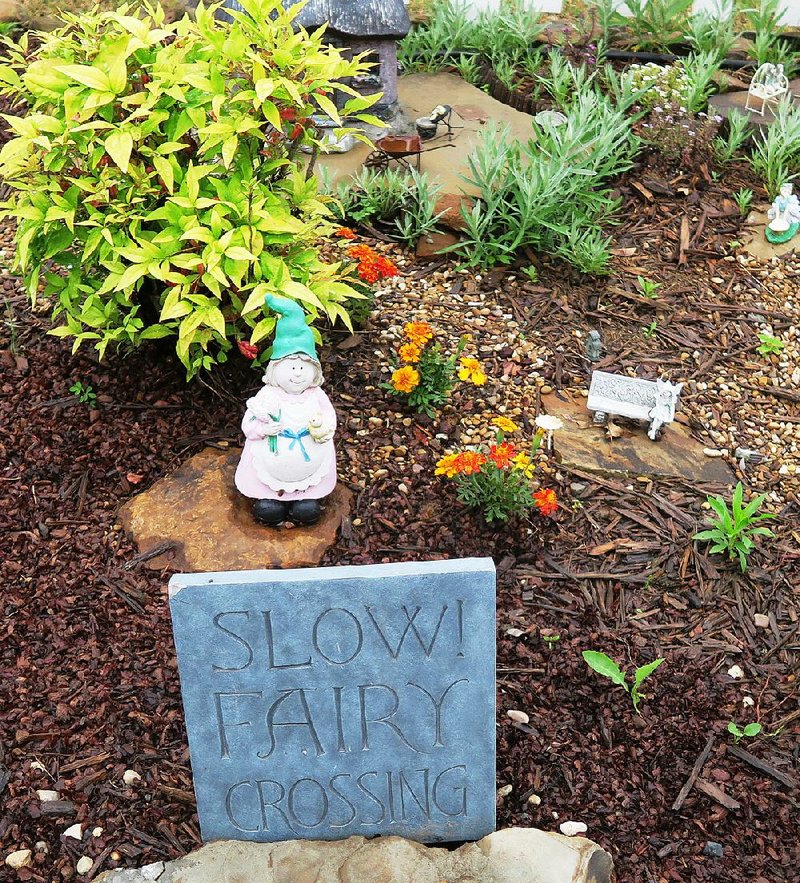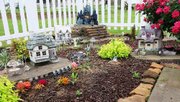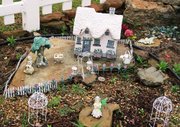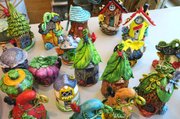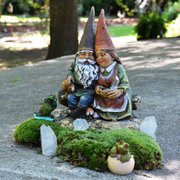Fascination with fairies isn't new. It dates from early Greek mythology, and who didn't love Tinkerbell? But only recently have so many Arkansans begun building fairy gardens.
Some aim to add whimsy to a larger garden or to express the hope that diminutive creatures with teeny-tiny wings will flit about from flower to flower.
This is not a children's pastime -- there is big business in fairy gardening, with houses, churches and entire mini villages designed to hold up to outdoor conditions. Furniture, figurines and anything you could imagine in a dollhouse are being designed for fairy gardens.
There is quite a bit of diversity when it comes to the size of fairy accessories, and there are no hard and fast guidelines concerning what makes something "fairy" ware, so choose whatever size you like.
Fairy gardens can be inside or outside, in a small nook or cranny or developed over a large space. They can be grown in containers or planted in the ground. Nestling them under a shade tree seems to be the most popular -- and what fairy wouldn't prefer to be out of the hot sun in the summer?
Just like the "secret gardens" that were popular a few years ago, fairy gardens allow gardeners to have fun using their imaginations. These projects also present educational
opportunities. Along with acquiring all the miniature accessories, you do have to plant the garden. Miniature landscapes require miniature plants, or at least plants that can be transformed to look small.
Think back to the terrarium fascination in the 1970s. Miniature plants are available, but you can also grow standard plants and prune or shape them to look like trees in the forest -- on a smaller scale.
OPTIONS ABOUND
When looking for fairy garden plants, you really do need to think small -- small leaves, small stature, small flowers. Dwarf plants and slow-growing plants are useful because they won't quickly take over the fairy landscape.
Just as with any garden, success boils down to finding the right plant for the right place. Match growing things to the conditions of your site: sun or shade, wet or dry, rich soil or rocky.
• Dwarf conifers are slow growing, come in a wide variety and can give you the "tree" look.
• Miniature or teacup hosta is a tiny version of the larger perennial hosta and works well.
• Groundcovers, including creeping blue star (Laurentia) and Pratia, can cover the ground with tiny leaves. Other groundcovers, including creeping Jenny, small leaved ajuga, small leaved pennywort and miniature mondo grass all work well.
• Moss is another good fill, and it hugs the ground; but it loves the shade.
• Thyme can be a good choice, since it has tiny leaves and is quite drought tolerant.
There is also a fascination with succulents, and they work well in the fairy garden. Most have tiny leaves, are low growing and spread slowly.
Just as the accessory vendors keep coming up with new "hardscape" items to decorate the fairy garden, whole lines of new miniature plants keep hitting the nurseries. So each year you can add to your fairy garden.
GOOD COMPANIONS
Diversity is a good thing in any garden, so choose plants that have seasonal interest and color.
Outdoor plants -- miniature roses, for instance -- can bloom all summer and give you great color, but you can also intersperse houseplants for the summer months: baby's tears, peperomias and even African violets could live among the fairies while it's warm.
But as with any garden, make sure plants that are used together need the same growing conditions, from light requirements to water and fertilizer.
Also, fairy gardens only look magical: There will still be weed control and normal maintenance work for the gardener. If plants become too crowded, you can thin them. If they get too tall, they can be pruned.
INSPIRATION
There was an old Celtic belief that fairies were driven away by humans to live in the Other World. A sweet story to tell about fairy gardens is that some fairies chose to stay among us. You can say they have magical powers, are shy and hide from humans, but would welcome a ready-made home-and-garden refuge.
Whether you believe in fairies or simply want to have some fun tending cute little growing things, plant a fairy garden. Inspiring examples are increasingly easy to find.
When Garvan Woodland Gardens in Hot Springs installed Mystic Creatures last summer with large topiary displays, it created a fairy village as well. The popularity of that village, complete with offerings from guests, led to a huge expansion this year, and it is now a permanent fairy garden display.
Janet B. Carson is a horticulture specialist for the University of Arkansas Cooperative Extension Service.
HomeStyle on 06/20/2015

